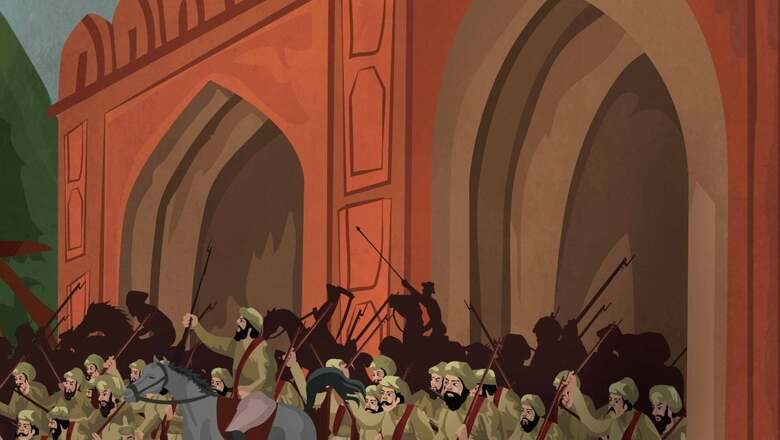
views
Preface
Seven years before the first war of Indian independence, Bahadur Shah Zafar was eking out a living with the pension that the British supplied him. The phrase “eking out a living” can be interpreted in two ways in Zafar’s context. The first: Here was a Mughal who had upended the relationship between monarch and supplicant. His ancestor Jahangir had made Thomas Roe and other Europeans bow before him as supplicants. Zafar’s status was slightly higher than that of a pauper content to feed off the British crumbs. The second: The pauperised status did not deter the deluded Bahadur Shah Zafar from basking in the illusion that his Mughal House still commanded the same prestige as before. He continuously fed the delusion with the same British pension, lavishing it on jewellery, gardens, festivities, parties and extravagant decadence. When the money ran out ahead of the next deposit of the pension, he borrowed still more and borrowed copiously.
Bahadur Shah Zafar’s self-created chimera of Mughal prestige was so pathetic that he once refused entry to the Nawab of Bahawalpur unless he took off his Kulge. Zafar also had the temerity to refuse a chair to the British Resident and disallow the Commander-in-Chief to enter the Diwan-i-Aam (audience hall for the public) on horseback. These were the same officials who supplied him with his regular dole.
And the grand Red Fort was the grand structural symbolism and reality of this delusion of grandeur. Concretely.
An intriguing document titled Precis of Palace Intelligence running 800 pages furnishes first-hand details of life inside Bahadur Shah’s Red Fort. It is actually a compilation of weekly diaries beginning on January 6, 1851, and ending on January 1, 1854. Every week’s diary bears the signature of the British Resident of Delhi. Its purpose was clearly political: to collect and report intelligence on the activities of Bahadur Shah Zafar to the Governor General. One great value of the document is the sheer wealth of details that it offers about the personal life of Zafar, his begums, his vast harem, his princes and the social and cultural life inside the Red Fort, which housed 2,000 people.
The picture is horrific, to say the least.
We’re treated to an orgy of ruin on an epic scale. On the political front, we witness a doddering old nominal sultan in the amorous thrall of his powerful begum. We witness his utter political enervation in the manner in which a mere Vizier from Lucknow fools him. We see the Nawab of Avadh flouting this token of Mughal authority with impunity. We see how he has become a willing pawn in the hands of his courtiers and a physician all of whom wield real power. We see how he has completely devoted his life to the pursuit of pleasure via minute details of his daily routine. We see him wasting fabulous sums on weddings. We see his princes and other royalty rivalling each other in maintaining concubines and slave girls. We notice how bootlegging has burgeoned into a thriving industry because wine drinking was banned. We see how the Red Fort economy was subsidised by the British pension, which artificially kept the prices low, yet, his begums had somehow managed to notch up enormous debt.
We see all portents of an ensuing cataclysm. Small wonder that when it actually ensued, Bahadur Shah Zafar, the last Mughal, also turned out to be the last great traitor of the 1857 freedom struggle.
Facets of the Life of Bahadur Shah
Bahadur Shah was in the thrall of his queen Zeenat Mahal whom he had married in 1840. Under her influence, he made repeated attempts to install her son Mirza Jawan Bakht the heir apparent to the throne of Delhi. Mirza was just 11 years old. Under her influence, he humiliated and ill-treated his elder sons. He slashed the allowance of a son, Mirza Fakhruddeen. He also tried to increase the importance of Mirza Jawan Bakht by sending him as his representative on various occasions.
An important official named Mirza Hyder Shekoh once came from Lucknow and met Bahadur Shah Zafar. This episode reveals the extent of Zafar’s powerlessness. The Avadh Court had become more powerful than the “emperor” of Delhi. It openly declared that Bahadur Shah Zafar had no right to confer titles and Khillats on government servants. Avadh indeed toyed with Zafar’s mind. It circulated rumours in Lucknow that Zafar was willing to become a Shia. It was a calculated affront but Zafar could only issue a feeble protest.
***
The daily routine of Zafar was divided into two parts. The first began early in the morning and the second, at about four in the afternoon. Though he was 76 years old, he was pretty energetic and used the energy to go out hunting every day except when he was ill. He was famed as a good hunter.
As we’ve seen, Zafar spent the pension he received from the British on wasteful expenditures. One of his high-ranking officers, Kanwar Devi Singh, announced his daughter’s marriage. Zafar sent highly expensive bridal dresses to her as a wedding gift. Likewise, he gave Rs 2,000 to Hakim Ahsanullah Khan on the occasion of the marriage of his daughter. And when a man named Miza Lateef Buksh died, Zafar gave Rs 200 for his funeral feast and burial.
Wives and Concubines and Sons
Begum Zeenat Mahal was clearly the favourite wife of Bahadur Shah Zafar. It didn’t take long for her to stamp her dominance throughout the wreckage called the Mughal Empire. She attended important meetings seated behind the purdah. And got what she wanted. Every single time.
In 1853, she made Zafar issue a Hukumnama to all his officers. Henceforth, they had to submit every petition through Zeenat Mahal. He was so enamoured by her that he once stayed in her mansion for an entire fortnight, absenting himself from the Red Fort.
Other important wives of Zafar included Taj Mahal Begum and Shurafat Mahal Begum. He also had a sprawling harem housing a prolific number of concubines. Some significant names are mentioned in the Precis: Khrum Bai, Dilruba, Pyari Bai, Sujan Bai, Islamunissa and Aramulnissa Khannum.
Bahadur Shah Zafar’s abundant male progeny comprised Mirza Jawan Bakht, Mirza Fakhruddin, Mirza Mughal and Mirza Abdullah. Mirza Fakhruddin, who was supposed to be the official heir apparent had been sidelined, thanks to the skulduggery of Zeenat Mahal. Needless, he nursed a permanent grudge against his own father.
Despite this sordid mess and all-round ruin and his own powerlessness, Bahadur Shah Zafar still harboured an exaggerated notion of the prestige of the Mughal House.
To be continued.
The author is the founder and chief editor, The Dharma Dispatch. Views expressed are personal.



















Comments
0 comment